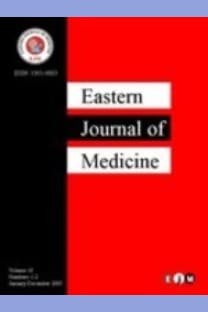Asymmetry relations between laterality IQ memory and management of dominant hemispheres in twins
Asymmetry relations between laterality IQ memory and management of dominant hemispheres in twins
Handedness, IQ, laterality dominant hemispheres, twins,
___
- Geschwind N, Behan P. Left-handedness: association with immune disease, migraine, and developmental learning disorder. Proc Natl Acad Sci U S A 1982; 79: 5097-100.
- Su CH, Kuo PH, Lin CC, Chen WJ. A school-based twin study of handedness among adolescents in Taiwan. Behav Genet 2005; 35: 723-33.
- Vuoksimaa E, Koskenvuo M, Rose RJ, Kaprio J. Origins of handedness: a nationwide study of 30161 adults. Neuropsychologia 2009; 47: 1294-1301.
- Galton, F. The history of twins, as a criterion of the relative powers of nature and nurture. J. Anthropol. Inst 1875; 12: 566-576.
- Reiss M, Tymnik G, Kögler P, Kögler W, Reiss G. Laterality of hand, foot, eye, and ear in twins. Laterality 1999; 4: 287-297.
- Bishop DVM. Handedness and specific language impairment: A study of 6‐year‐old twins. Developmental psychobiology 2005; 46: 362-369.
- Rosch RE, Ronan L, Cherkas L, Gurd JM. Cerebellar asymmetry in a pair of monozygotic handedness‐discordant twins. Journal of anatomy 2010; 217: 38-47.
- Suzuki K, Ando J. Genetic and environmental structure of individual differences in hand, foot, and ear preferences: A twin study. Laterality Asymmetries of Body Brain and Cognition 2014; 19: 113-128.
- Segal NL. Origins and imlications of handedness and relative birth weight for IQ in MZ twin pairs. Neuropsychol 1989; 27: 549-561.
- Oldfield RC. The assessment and analysis of handedness: the Edinburgh inventory. Neuropsychologia 1971; 9: 97-113.
- Yetkin Y. The examination of preferences related to using of right or left hand, foot and eye. Trends J Med Sci 1993; 19: 133-142.
- Tan Ü. The distribution of hand preference in normal men and women. International Journal of Neuroscience 1988; 41: 35-55.
- Cattell RB. A culture-free intelligence test. I. Journal of Educational Psychology 1940; 31: 161.
- Alder H. The Right Brain Manager: How to Use the Power of Your Mind to Achieve Personal and Professional Success (2nd ed). London: Piatkus Books, 1999.
- Fraga MF, Ballestar E, Paz MF, et al. Epigenetic differences arise during the lifetime of monozygotic twins. Proceedings of the National Academy of Sciences of the United States of America 2005; 102: 10604-10609.
- Ellis SJ, Ellis PJ, Marshall E. Hand preference in a normal population. Cortex 1988; 24:157-163.
- Shimizu A, Endo M. Comparison of patterns of handedness between twins and singletons in Japan. Cortex 1983; 19: 345-352.
- Sicotte NL, Woods RP, Mazziotta JC. Handedness in twins: a meta-analysis. Laterality Asymmetries of Body Brain and Cognition 1999; 4: 265-286.
- Kıylık B. The relationship between the right hemisphere management and the dominance of the left hemisphere in right-and left handers. Yuzuncu Yıl University, Healthy Sciences Institute, MA Thesis in Department of Physiology, Van, Turkey, 2005.
- Ronalds GA, De Stavola BL, Leon DA. The cognitive cost of being a twin: evidence from comparisons within families in the Aberdeen children of the 1950s cohort study. BMJ 2005; 331:1306.
- Posthuma D, De Geus EJ, Bleichrodt N, Boomsma DI. Twin–singleton differences in intelligence? Twin Research 2000; 3: 83-87.
- ISSN: 1301-0883
- Yayın Aralığı: 4
- Başlangıç: 1996
- Yayıncı: ERBİL KARAMAN
Asymmetry relations between laterality IQ memory and management of dominant hemispheres in twins
Özlem ERGÜL ERKEÇ, Yalçın YETKİN
Osman TOKTAŞ, Alpaslan YAVUZ, Gülay BULUT, Sıddık KESKİN, Ümit İLİKLERDEN, M. Çetin KOTAN
Two novel features in Lin-Gettig Syndrome: Double nuchal fold and nail hypoplasia
Sultan KABA, Murat DOĞAN, Keziban BULAN, Selami KOCAMAN, Serap KILIÇ KARAMAN
Okan ARIHAN, Hanefi ÖZBEK, Ayşe GENÇLER ÖZKAN
Primary Extraskeletal Ewing’s sarcoma of the posterior neck
Cengiz DURUCU, Seceattin GULSEN, Ela DURUCU
Turner Syndrome with 45,X/46,XY mosaicism underwent gonadectomy: Report of 3 cases
Aytekin TOKMAK, Burak AKSELİM, Hüseyin YEŞİLYURT
Ultrasonographic screening of single umbilical artery: Management and perinatal outcomes
Mehmet SAKAR, İsmet GUN, Bulent DEMİR, Sureyya DEMİR, Ali ZEBİTAY
Malaria: An evaluation of three Africa-borne cases
Mahmut SUNNETCİOGLU, Mehmet Resat CEYLAN, Ümit YAKAN, Hasan KARSEN, Mustafa Kasım KARAHOCAGİL
Kerem TAKEN, Müslüm ERGÜN, Recep ERYILMAZ, Sait YAMİŞ, Mustafa GÜNES, İlhan GECİT, Kadir CEYLAN
Halis ÖZDEMİR, Hakan KALAYCI, Nihal ŞAHİN UYSAL, Huriye PARLAKGÜMÜŞ, Tayfun ÇOK, Ebru TARIM, Filiz BİLGİN YANIK
